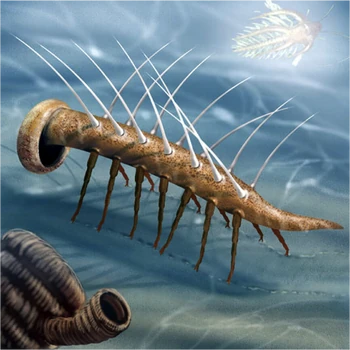Marrella splendens is an arthropod known from the middle Cambrian Burgess Shale of British Columbia. It is the most common animal in the Burgess Shale. They are maybe Lobopods like Anomalocaris, Opabinia, Hurdia, Aysheaia and Hallucigenia.

Marrella and Hallucigenia
History[]
Marrella was the first fossil collected by Charles Doolittle Walcott from the Burgess Shale. Walcott described Marrella informally as a "lace crab" and described it more formally as an odd trilobite. It was later reassigned to the now defunct class Trilobitoidea in the Treatise on Invertebrate Paleontology. In 1971, Whittington did a thorough redescription of the animal and, on the basis of its legs, gills and head appendages, concluded that it was neither a trilobite, nor a chelicerate, nor a crustacean. Taken with two other unexpectedly unique arthropod-like organisms, Opabinia and Yohoia, Marrella helped to demonstrate that the soft-bodied Burgess fauna was more complex and diverse than had previously been suspected.
Morphology[]
Marrella itself is a small animal, 2 cm or less in length. The head shield has two pairs of long rearward spikes. On the underside of the head are two pairs of antennae, one long and sweeping, the second shorter and stouter. Marrella has a body composed of 24–26 body segments, each with a pair of branched appendages. The lower branch of each appendage is a leg for walking, while the upper branch is a long, feathery gill. There is a tiny, button-like telson at the end of the thorax. It is unclear how the unmineralized head and spines were stiffened. Marrella has too many antennae, too few cephalic legs, and too few segments per leg to be a trilobite. It lacks the three pairs of legs behind the mouth that are characteristic of crustacea. The legs are also quite different from those of crustaceans. The identification of a diffraction grating pattern on well-preserved Marrella specimens proves that it would have harboured an iridescent sheen—and thus would have appeared colourful. A dark stain is often present at the rear of the organism, probably representing decay fluids.
Ecology[]
Marrella is thought to have been a benthic (bottom-dwelling) marine scavenger living on detrital and particulate material. One exceptional specimen shows the organism fossilized in the act of moulting.
Taxonomy[]
It is currently accepted that Marrella is a stem group arthropod—in other words, it is descended from an ancestor common to it and most or all of the later major arthropod groups. Despite its similarity to the trilobites, it is no more closely related to this group than any other arthropod.
Occurrence[]
Marrella is the most abundant genus in the Burgess Shale. Most Marrella specimens herald from the 'Marrella bed', a thin horizon, but it is common in most other outcrops of the shale. Over 25 000 specimens have been collected; 5028 specimens of Marrella are known from the Greater Phyllopod bed, where they comprise 9.56% of the community.Marrellomorphs—that is, Marrella-like organisms—are well distributed in other Cambrian deposits, and are indeed known from sediments as late as the Devonian.
In Popular Culture[]
Marrellas appeared in every scene like more than one in the Website The Burgess Shale in the Virtual Sea Odyssey.
Gallery[]
Marrella/Gallery